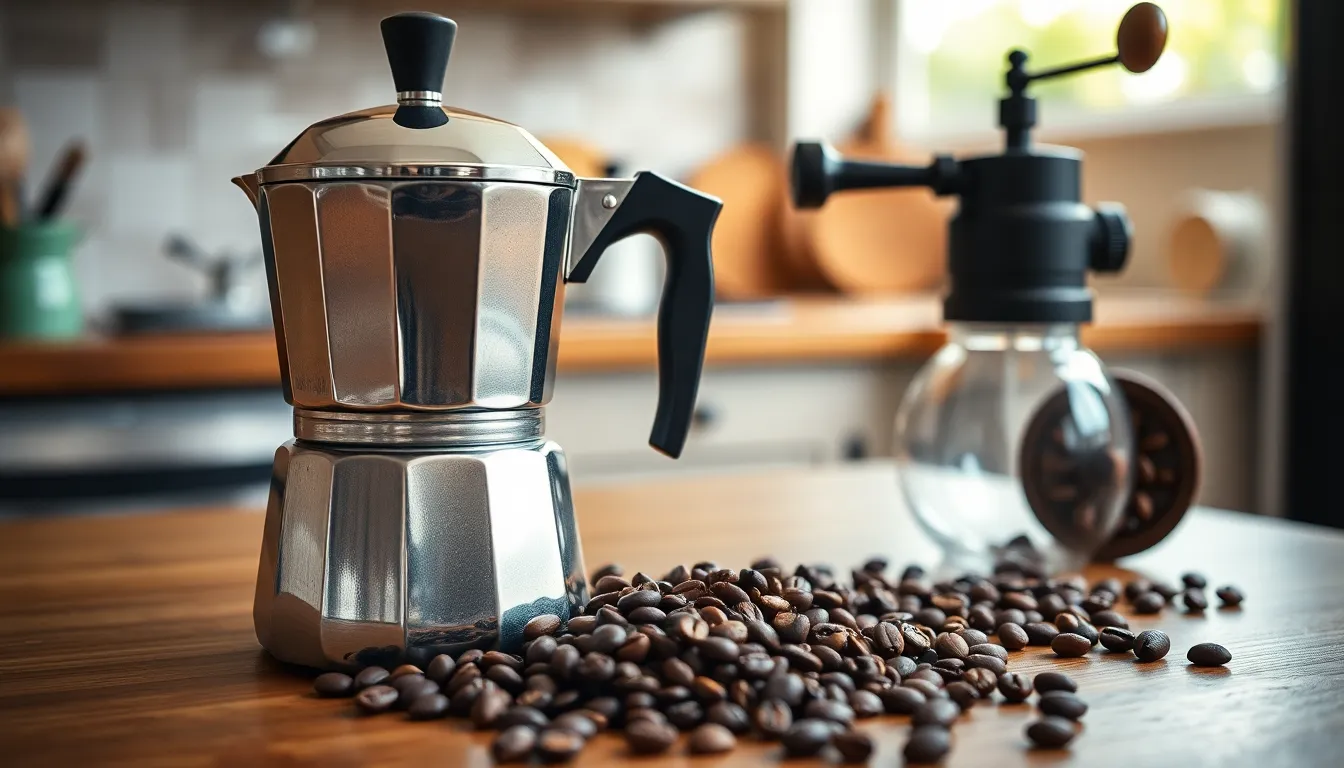Wondering about the perfect grind size for your Moka pot? Getting it right can make the difference between a rich, flavorful coffee experience and a bitter disappointment.
The Moka pot, that iconic Italian stovetop brewer, demands exact attention to grind size. Unlike other brewing methods, it’s particularly sensitive to how coarsely or finely you grind your beans. When you nail the grind size—somewhere between espresso fine and drip coffee coarse—you’ll unlock the full potential of this classic coffee maker. Let’s jump into exactly what grind works best and why it matters so much for your morning brew.
Understanding the Moka Pot Brewing Method
The Moka pot, invented by Alfonso Bialetti in 1933, creates a rich, concentrated coffee through a unique pressure-brewing system. It’s composed of three main chambers: the bottom water chamber, the middle filter basket for ground coffee, and the top collection chamber where brewed coffee emerges.
During brewing, water in the bottom chamber heats up, creating pressure that forces hot water through the coffee grounds and up into the collection chamber. This pressure-driven extraction produces coffee with a strength between espresso and drip coffee, featuring a distinctive robust flavor profile with deep notes and substantial body.
Unlike other brewing methods, the Moka pot relies on exact brewing parameters to achieve optimal results. The water temperature reaches nearly boiling point (203-205°F), while the brewing pressure ranges from 1-2 bars – significantly lower than espresso machines but higher than pour-over methods. Extraction time typically runs between 4-5 minutes, depending on heat source intensity and pot size.
The Moka pot’s unique brewing physics demands attention to grind size consistency. Particles too fine can block water flow and create excessive pressure, while overly coarse grounds allow water to pass through too quickly without proper extraction. Finding the sweet spot ensures proper resistance to water flow while allowing complete saturation of coffee particles.
Why Grind Size Matters for Moka Pot Coffee
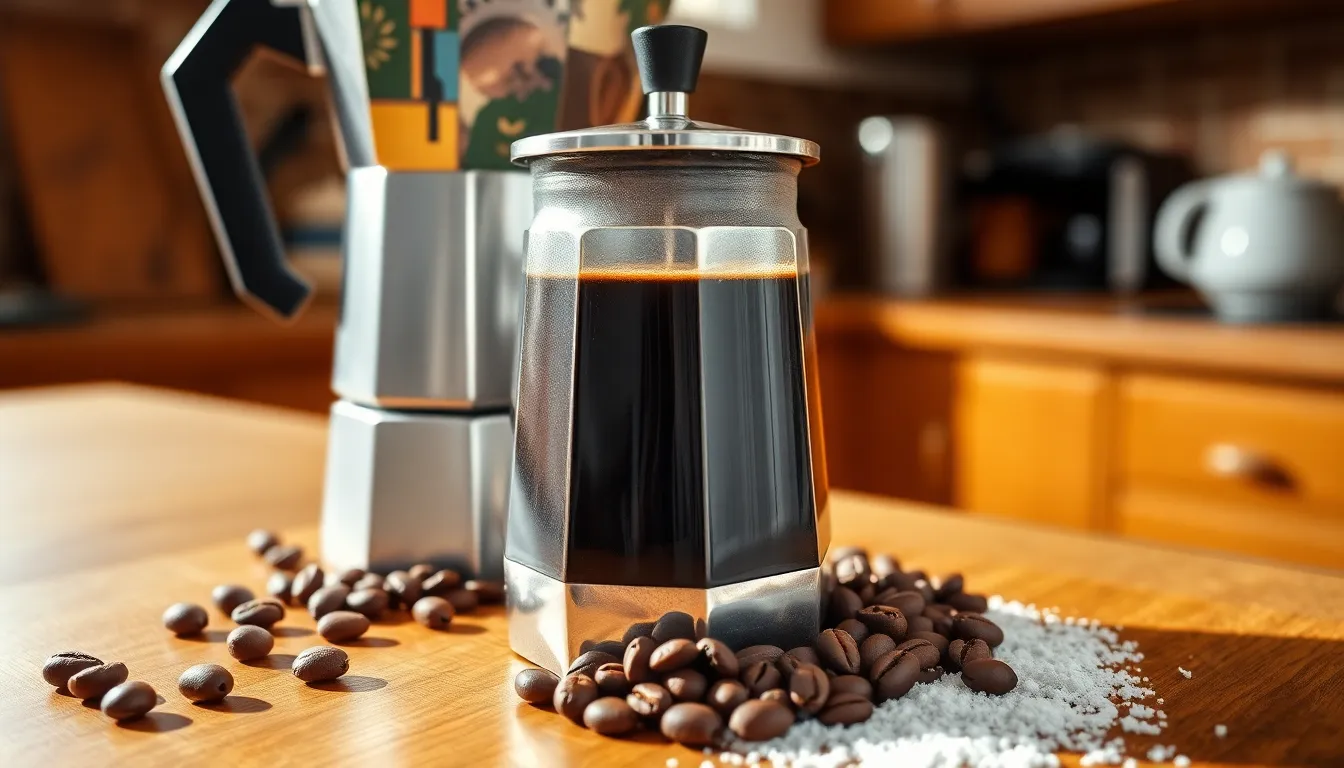
Proper Extraction and Flavor Balance
A medium-fine grind creates the perfect environment for balanced extraction in your Moka pot. This grind size allows water to flow evenly through the coffee grounds under the 1-2 bars of pressure that a Moka pot generates. Coffee ground too coarsely results in weak, under-extracted coffee with a watery, sometimes sour taste. Grounds that are too fine lead to over-extraction, producing excessive bitterness and potentially clogging the filter, which disrupts the entire brewing process.
Pressure Generation
The physics of a Moka pot rely on proper grind size to function correctly. Your coffee grounds must be fine enough to create sufficient resistance in the brewing chamber. This resistance helps generate the pressure needed to force water upward through the coffee bed, producing that signature rich, robust Moka pot coffee that sits between drip coffee and espresso in strength and body.
Avoiding Clogging and Over-Extraction
Medium-fine grounds prevent common brewing problems that plague Moka pot users. While your grind should be finer than what you’d use for drip coffee, it shouldn’t approach espresso territory. Espresso-fine grounds block water flow through the filter, causing excessive pressure build-up that can be dangerous and resulting in bitter, unpleasant coffee. The ideal grind—similar to table salt in texture—allows water to pass through with just enough resistance to extract optimal flavor compounds without creating blockages.
Using a quality burr grinder achieves consistent medium-fine particles around 360-660 microns with approximately 98% size uniformity. This consistency maximizes flavor extraction while minimizing unwanted bitterness, ensuring your Moka pot produces its characteristic rich coffee with every brew.
The Ideal Grind Size for Moka Pot
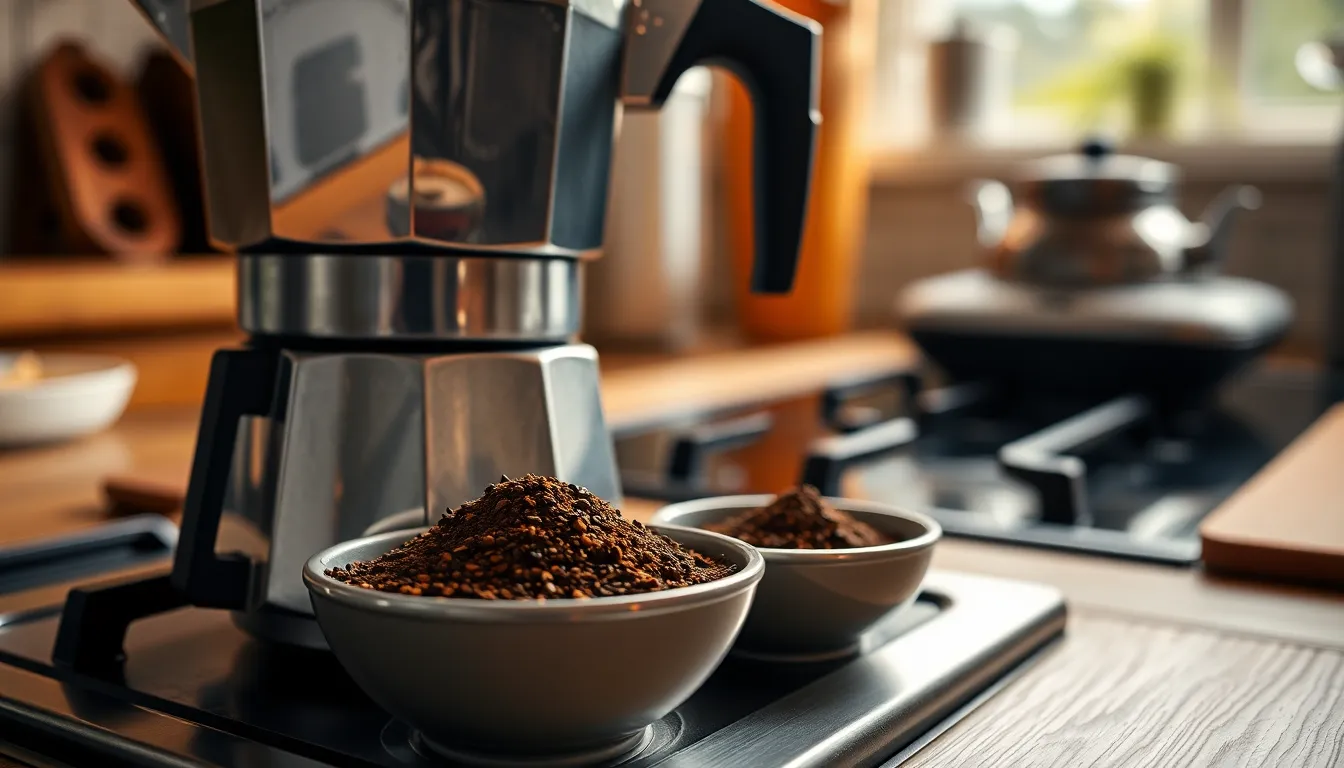
Finding the perfect grind size for your Moka pot is essential for extracting the full spectrum of flavors from your coffee beans. The right grind creates optimal pressure and flow during brewing, directly impacting taste, body, and aroma.
Medium-Fine Grind: The Sweet Spot
Medium-fine grounds provide the optimal balance for Moka pot brewing, sitting precisely between espresso and drip coffee textures. These grounds resemble granulated sugar or table salt, measuring approximately 650 microns in particle size—within the ideal range of 360 to 660 microns. Coffee ground to this consistency creates just enough resistance for water to flow evenly through the coffee bed, extracting balanced flavors without causing blockages. This grind size generates the proper pressure (1-2 bars) needed for Moka pot brewing while preventing both over-extraction that leads to bitterness and under-extraction that results in watery coffee. Many coffee enthusiasts find that this grind consistency produces the rich, velvety mouthfeel characteristic of quality Moka pot coffee.
Comparing Moka Pot Grind to Other Brewing Methods
Moka pot grind occupies a middle position in the spectrum of coffee grinding, reflecting its unique brewing mechanics. The difference becomes clear when comparing various brewing methods:
| Brew Method | Grind Size | Texture Comparison |
|---|---|---|
| Espresso | Fine | Powdery, like flour |
| Moka Pot | Medium-Fine | Granulated sugar/table salt |
| Drip Coffee | Medium | Coarser than Moka pot grind |
This intermediate grind size corresponds directly to the Moka pot’s pressure system—higher than gravity-fed drip methods but significantly lower than commercial espresso machines. Grinding too fine (espresso-level) creates excessive resistance that can lead to bitter flavors or even dangerous pressure buildup. Conversely, grinding too coarse like for French press allows water to pass through too quickly, yielding thin, under-extracted coffee lacking depth and complexity. The medium-fine grind creates the perfect environment for the Moka pot’s moderate pressure to extract rich, balanced coffee with impressive consistency.
How to Achieve the Perfect Grind at Home
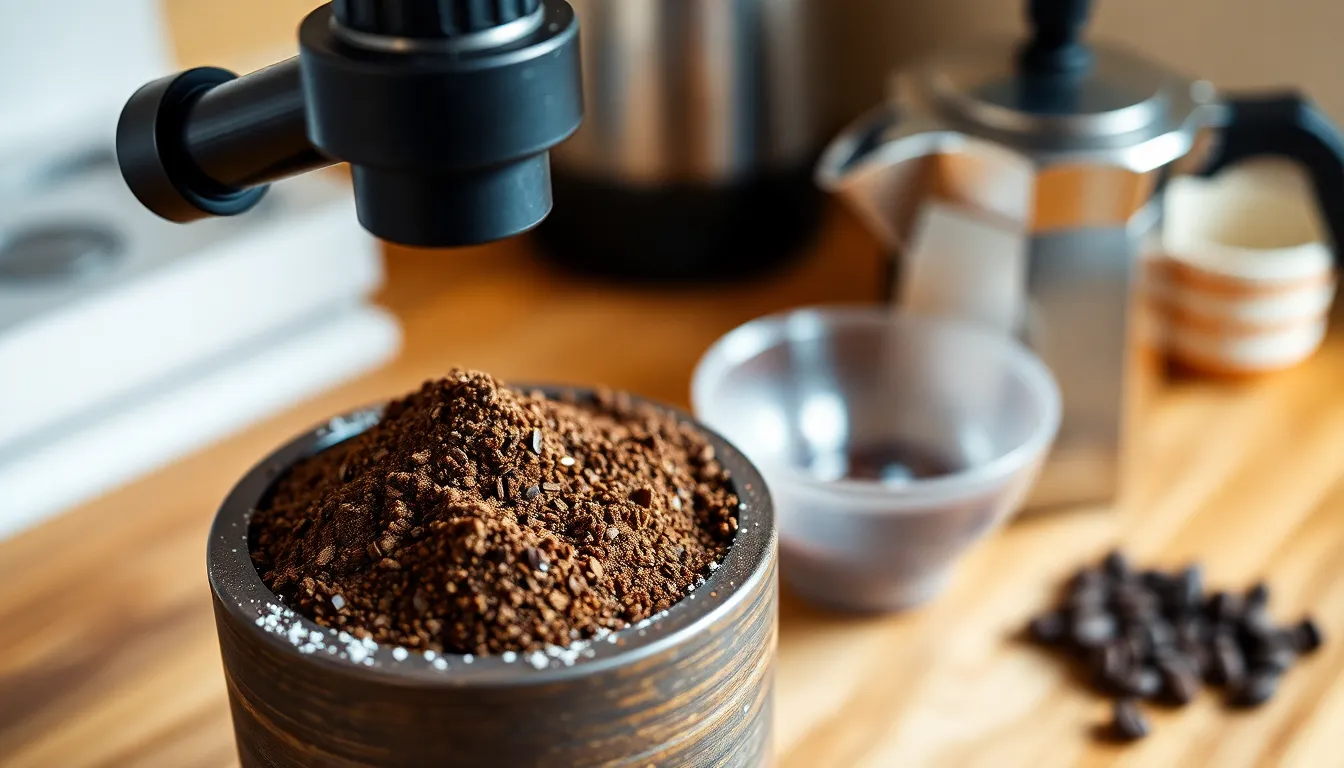
Achieving the ideal medium-fine grind for your moka pot at home requires the right equipment and technique. A proper grind measures between 360 to 660 microns in particle size, sitting between table salt and flour in texture, allowing optimal water flow and pressure generation for a balanced extraction.
Manual vs. Electric Grinders for Moka Pot
Manual grinders offer excellent control over the medium-fine grind needed for moka pot brewing. These hand-operated tools create consistent particles through a slower, more deliberate grinding process that many coffee enthusiasts appreciate for its ritualistic quality. High-quality manual burr grinders produce remarkably uniform grounds that lead to balanced extraction in your moka pot.
Electric grinders come in two main varieties: burr and blade. Burr electric grinders deliver quick, consistent medium-fine grounds perfect for moka pot brewing, often featuring preset settings calibrated to the 360-660 micron range ideal for this brewing method. Blade grinders, while less consistent, can still produce acceptable results for moka pot coffee when used carefully with proper technique.
For daily moka pot brewing, a burr grinder (either manual or electric) represents the best investment. These grinders create the precise, uniform medium-fine texture that allows your moka pot to build proper pressure without clogging the filter. Freshly grinding your beans immediately before brewing significantly enhances flavor complexity compared to pre-ground coffee.
Visual Guide to Identifying the Right Grind
The perfect moka pot grind resembles granulated sugar or table salt in appearance – not as fine as flour but finer than coarse sea salt. Your grounds should appear as small, uniform granules that feel slightly gritty between your fingers when touched. This consistency allows optimal water flow through the coffee bed while maintaining enough resistance for proper extraction.
Visually inspecting your ground coffee provides immediate feedback about grind consistency. The particles should be distinguishable individually but significantly smaller than grounds used for drip coffee methods. An inconsistent grind with varying particle sizes leads to uneven extraction, where some particles over-extract (creating bitterness) while others under-extract (resulting in weak flavors).
Testing your grind between your fingers offers tactile confirmation – the grounds should feel slightly rough but not powdery or chunky. This medium-fine texture creates the perfect environment for the moka pot’s pressure system to extract rich, balanced flavors without clogging or channeling. Adjust your grinder setting slightly finer or coarser based on tasting results until you achieve your preferred flavor profile.
Common Grind Size Mistakes to Avoid
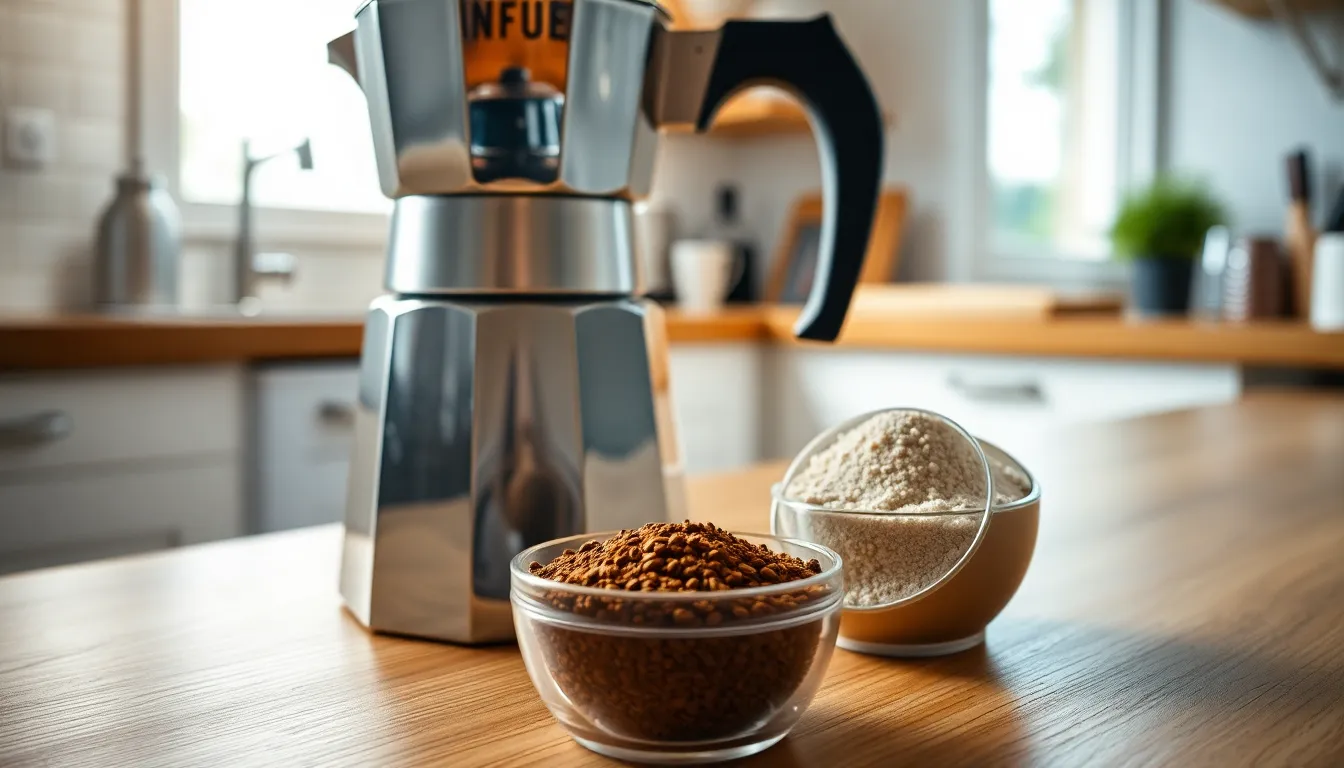
Achieving the perfect cup of coffee from your Moka pot depends significantly on avoiding critical grind size errors. Even minor deviations from the ideal medium-fine texture can dramatically alter your brewing results and coffee flavor profile.
Too Fine: Dealing with Over-Extraction
Coffee ground too finely for a Moka pot creates several immediate problems in your brewing process. Grounds resembling espresso fineness or powder consistency block water flow through the filter basket, causing excessive pressure buildup that can be potentially dangerous. This restriction forces the water to extract too many compounds from the coffee, including undesirable bitter elements that overwhelm the cup. Over-extracted coffee from excessively fine grounds typically tastes harsh, astringent, and intensely bitter, lacking the balanced complexity that makes Moka pot coffee special.
To remedy an over-extraction situation, immediately adjust your grinder to a coarser setting that matches the texture of table salt or granulated sugar (approximately 650 microns). Cleaning your Moka pot thoroughly after an over-extraction brew is essential, as fine particles tend to clog the filter plate and impact future brewing sessions.
Too Coarse: Solving Under-Extraction Issues
Grounds that are too coarse create the opposite problem – under-extraction that produces weak, unsatisfying coffee. When your grind resembles drip or French press coarseness, water rushes through the coffee bed too quickly without extracting sufficient flavor compounds. Under-extracted Moka pot coffee often tastes noticeably sour, watery, and lacks the signature robust character that makes this brewing method popular. The insufficient resistance from coarse grounds prevents the Moka pot from building the 1-2 bars of pressure needed for proper extraction.
Fixing under-extraction requires adjusting your grinder to produce a medium-fine consistency between 360-660 microns. Properly ground coffee creates just enough resistance for the water to extract a balanced flavor profile while maintaining adequate flow through the filter. Tamping the grounds lightly in the filter basket can sometimes help compensate for slightly coarse grounds, though this isn’t an ideal long-term solution compared to correcting your grind size.
How Grind Size Affects Flavor Profile
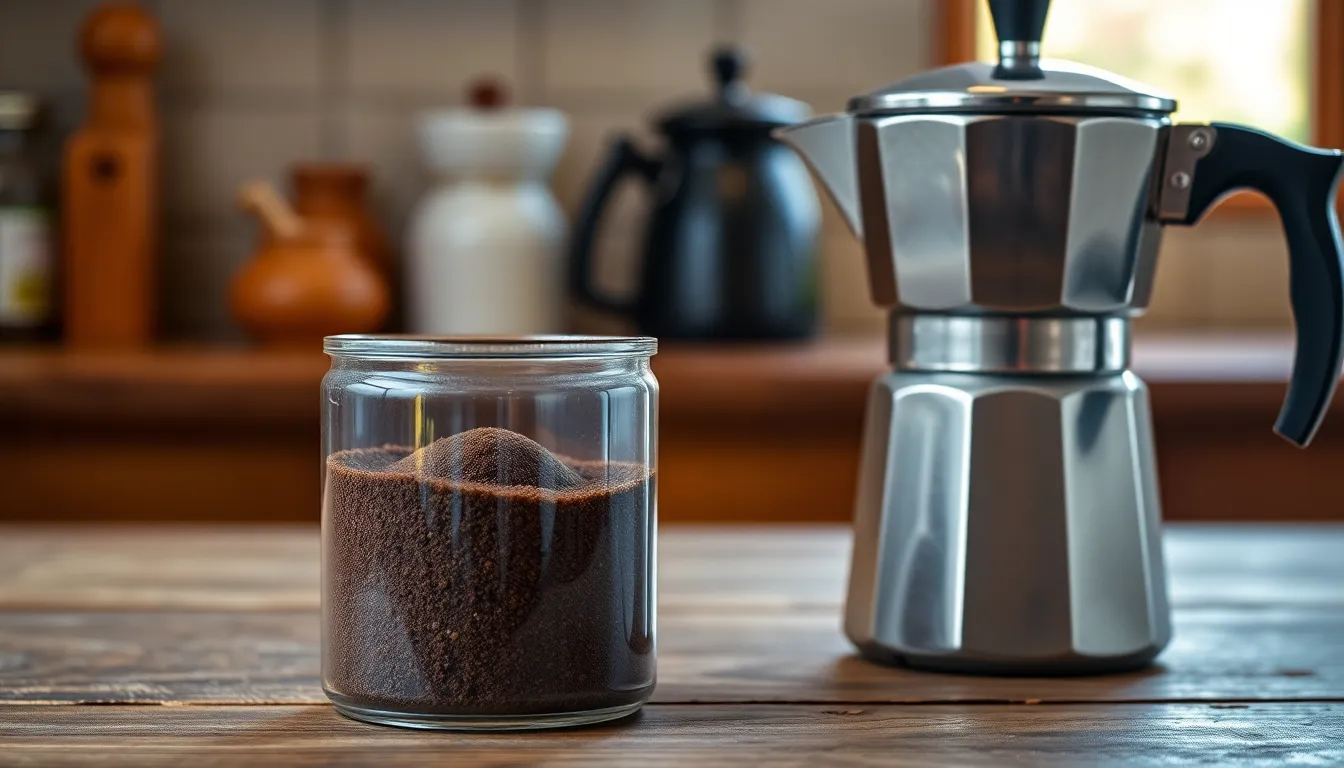
The medium-fine grind size creates a balanced extraction that unlocks sweet, complex flavors in your Moka pot coffee. This optimal particle size (360-660 microns) resembles slightly finer than table salt but coarser than flour, providing the perfect resistance for water to extract flavors evenly. Uniform particle size ensures consistent extraction throughout the coffee bed.
Grinding too fine leads to over-extraction, where excessive compounds dissolve into your brew. These over-extracted compounds introduce bitter and astringent notes that overpower the coffee’s natural sweetness. Fine grounds also create too much resistance, potentially causing pressure buildup and brewing issues.
Coarse grounds produce the opposite problem – under-extraction. Water passes through large coffee particles too quickly, failing to dissolve enough flavor compounds. Under-extracted coffee tastes noticeably sour, weak, and lacks the rich body Moka pots are known for producing.
Consistency in your grind matters as much as the size itself. A grind that’s 98% consistent, similar to granulated sugar or table salt, creates even extraction across all particles. Inconsistent grounds extract unevenly, with some particles over-extracting while others under-extract, resulting in a muddled flavor profile that lacks clarity.
Pre-ground coffee works in a pinch if it matches the medium-fine consistency needed for Moka pots. Store pre-ground coffee in an airtight container to preserve freshness, though freshly ground beans always provide superior flavor due to minimal oxidation.
Adjusting Grind Size Based on Your Coffee Bean Type

Different coffee beans require exact grind adjustments for optimal extraction in your Moka pot. The roast level, origin, and processing method of your beans all influence how finely you should grind them to achieve the best flavor balance.
Light Roasts vs. Dark Roasts
Light roasts contain denser cellular structures that resist water penetration during brewing. These beans benefit from a slightly finer grind (closer to 360 microns) to increase extraction efficiency and release their bright, complex flavors. Dark roasts, having undergone longer roasting that breaks down cell structures, extract more readily and work better with a medium-fine grind (around 600 microns) to prevent over-extraction and excessive bitterness.
Single-Origin Considerations
Single-origin beans from different regions display unique characteristics that respond differently to grind adjustments:
- Ethiopian beans: Their delicate floral notes often require a slightly finer grind to properly extract the subtle aromatics
- Colombian beans: Their balanced profile works well with the standard medium-fine grind (400-500 microns)
- Brazilian beans: Their nutty, chocolatey flavors extract efficiently with a medium grind approaching the coarser end of the recommended range
Freshness Factors
Fresh beans contain more CO2 and volatile compounds that affect extraction. Beans within 5-15 days after roasting often create more resistance during brewing, making a slightly coarser grind beneficial. Older beans (beyond 3 weeks) may benefit from a finer grind to compensate for decreased volatile compounds and to enhance extraction potential.
Processing Method Impacts
The way coffee beans are processed before roasting affects their density and extraction properties:
- Washed coffees: These cleaner, more structured beans typically work well with the standard medium-fine grind
- Natural processed coffees: Their fruitier profile and different cellular structure often extract more efficiently with a slightly coarser adjustment
- Honey processed beans: These fall between washed and natural, requiring careful testing to find the optimal grind setting
For consistent results, maintain grind uniformity regardless of which adjustment you make. High-quality burr grinders provide the 98% consistency needed to properly accommodate these bean-exact adjustments while maintaining the essential medium-fine texture required for Moka pot brewing.
Conclusion
Getting your Moka pot grind size right is the key to unlocking those rich flavors you’re after. Aim for that medium-fine consistency similar to table salt to strike the perfect balance between extraction and flow.
Remember that your grind needs to match your beans too – slightly finer for light roasts and medium-fine for dark roasts. Investing in a quality burr grinder will make all the difference in achieving this consistency.
Don’t be afraid to experiment and adjust based on taste. Small tweaks to your grind size can transform your morning brew from good to exceptional. With the right grind between 360-660 microns you’ll enjoy that signature Moka pot richness every time you brew.
Frequently Asked Questions
What is the ideal grind size for a Moka pot?
The ideal grind size for a Moka pot is medium-fine, similar to table salt or granulated sugar (approximately 650 microns). This grind size falls between espresso fine and drip coffee coarse, creating the perfect resistance for water flow while allowing optimal extraction. This consistency ensures balanced flavor without clogging the filter or causing over-extraction.
Why does grind size matter for Moka pot coffee?
Grind size controls extraction rate and pressure in a Moka pot. Too fine grounds cause over-extraction, bitterness, and possible clogging. Too coarse grounds lead to under-extraction and weak, sour coffee. The medium-fine grind creates ideal resistance for the 1-2 bars of pressure generated by the Moka pot, ensuring balanced extraction and optimal flavor development.
Can I use pre-ground coffee for my Moka pot?
Yes, you can use pre-ground coffee if it matches the medium-fine consistency needed for Moka pots. However, freshly ground beans will always provide superior flavor. When purchasing pre-ground coffee, look for options labeled specifically for Moka pot or stovetop espresso to ensure the appropriate grind size.
How do I know if my grind size is correct?
The correct Moka pot grind resembles table salt or granulated sugar. Visually check for consistency and uniform particle size. Perform a tactile test—the grounds should feel slightly gritty but not powdery or chunky. Most importantly, assess your brew results—adjust finer if coffee tastes weak or sour, and coarser if it’s bitter or extraction time exceeds 5 minutes.
Do different coffee beans require different grinds in a Moka pot?
Yes, different beans may require slight grind adjustments. Light roasts benefit from a slightly finer grind due to their density, while dark roasts work better with a medium-fine grind to avoid bitterness. Single-origin beans may need specific adjustments based on their unique characteristics. Always maintain the medium-fine texture range while making these subtle adjustments.
What grinder is best for Moka pot coffee?
Burr grinders are best for Moka pot coffee because they produce consistent particle sizes. Manual burr grinders offer excellent control and uniform grounds, making them ideal for precision. Electric burr grinders provide quick, consistent results for daily use. Blade grinders should be avoided as they produce inconsistent grounds that lead to uneven extraction and subpar coffee.
How does grind size affect brewing time in a Moka pot?
Grind size directly impacts brewing time. Finer grounds create more resistance, extending brewing time beyond the ideal 4-5 minutes and potentially causing over-extraction. Coarser grounds allow water to pass through too quickly, resulting in under-extraction and shorter brewing times. The proper medium-fine grind ensures balanced extraction within the optimal brewing window.
What happens if my grind is too fine for a Moka pot?
Grounds that are too fine can clog the filter, create excessive pressure, and cause over-extraction. This results in bitter, harsh coffee with burnt notes. The excessive pressure can also damage the pot’s safety valve or cause coffee to spray out unpredictably. In extreme cases, the pot might not brew at all due to complete blockage.

